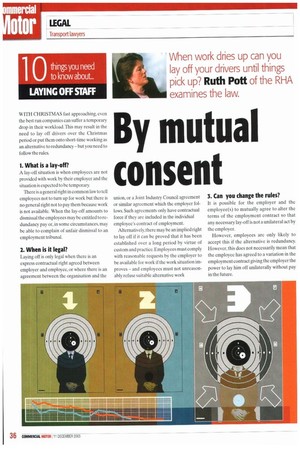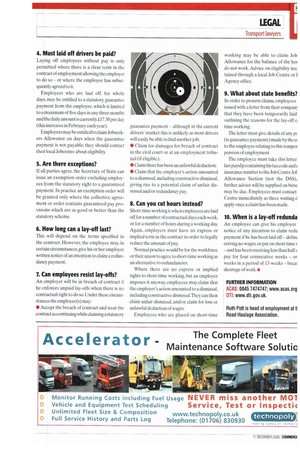By mutual consent
Page 38

Page 39

If you've noticed an error in this article please click here to report it so we can fix it.
union, or a Joint Industry Council agreement or similar agreement which the employer follows. Such agreements only have contractual force if they are included in the individual employee's contract of employment.
Alternatively, there may be an implied right to lay off if it can be proved that it has been established over a long period by virtue of custom and practice. Employees must comply with reasonable requests by the employer to be available for work if the work situation improves — and employees must not unreasonably refuse suitable alternative work
3. Can you change the rules?
It is possible for the employer and the employee(s) to mutually agree to alter the terms of the employment contract so that any necessary lay-off is not a unilateral act by the employer.
However, employees are only likely to accept this if the alternative is redundancy. However, this does not necessarily mean that the employee has agreed to a variation in the employment contract giving the employer the power to lay him off unilaterally without pay in the future. 4. Must laid off drivers be paid? Laying off employees without pay is only permitted where there is a clear term in the contract of employment allowing the employer to do so — or where the employee has subsequently agreed to it.
Employees who are laid off, for whole days, may be entitled to a statutory guarantee payment from the employer, which is limited to a maximum of five days in any three months and the daily amount is currently/17.30 per day (this increases in February each year).
Employees may be entitled to claim Jobseekers Allowance on days when the guarantee payment is not payable; they should contact their local Jobcentre about eligibility.
5. Are there exceptions?
It all parties agree. the Secretary of State can issue an exemption order excluding employees from the statutory right to a guaranteed payment. In practice an exemption order will be granted only where the collective agreement or order contains guaranteed pay provisions which are as good or better than the statutory scheme.
6. How long can a lay-off last?
This will depend on the terms specified in the contract. However, the employee may, in certain circumstances, give his or her employer written notice of an intention to claim a redundancy payment.
7. Can employees resist lay-offs? An employer will be in breach of contract if he enforces unpaid lay-offs when there is no contractual right to do so. Under these circumstances the employee(s) may: • Accept the breach of contract and treat the contract as continuing while claiming a statutory guarantee payment — although in the current drivers' market this is unlikely as most drivers will easily be able to find another job; • Claim for damages for breach of contract in the civil court or at an employment tribunal (if eligible): • Claim there has been an unlawful deduction; • Claim that the employer's action amounted to a dismissal, including constructive dismissal, giving rise to a potential claim of unfair dismissal and/or redundancy pay.
8. Can you cut hours instead? Short-time working is when employees are laid off for a number of contractual days each week, or for a number of hours during a working day. Again, employers must have an express or implied term in the contract in order to legally reduce the amount of pay.
Normal practice would be for the workforce or their union to agree to short-time working as an alternative to redundancies.
Where there are no express or implied rights to short-time working. but an employer imposes it anyway, employees may claim that the employer's action amounted to a dismissal. including constructive dismissaUThey can then claim unfair dismissal, and/or claim for loss or unlawful deduction of wages.
Employees who are placed on short-time working may be able to claim Job Allowance for the balance of the hoi do not work. Advice on eligibility ma: tamed through a local Job Centre or Agency office.
9. What about state benefits? In order to process claims, employees issued with a letter from their compan■ that they have been temporarily laid outlining the reasons for the lay-off o time working.
The letter must give details of any pf (ie guarantee payments) made by the c■ to the employee relating to this tempoi pension of employment.
The employee must take this letter last payslip containing his tax code and insurance number to the Job Centre Jot Allowance Section (not the DSS), further advice will be supplied on bene may be due. Employees must contact Centre immediately as three waiting d apply once a claim has been made.
10. When is a lay-off redunda An employee can give his employer notice of any intention to claim redu payment if he has been laid off — define ceiving no wages. or put on short-time — and has been receiving less than half z pay for four consecutive weeks — or weeks in a period of 13 weeks — becal shortage of work.•


























































































































































































